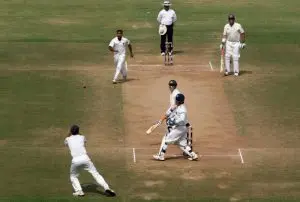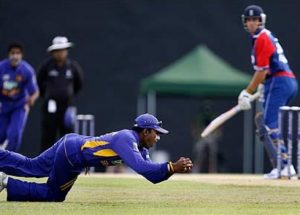The art and craft of slip fielding
View : 904
6 Min Read


The art and craft of slip fielding: Whatever be your special skill batting, bowling or both, you will always spend more time fielding than doing anything else in a normal cricket match. Fielding in the slips is quite strenuous. Bending at the knees when the bowler starts his run up and staying still in the process needs a lot of strength and muscle endurance to withstand fatigue. For the slip fielder, standing in the slips for 90 overs – 540 deliveries – in a day can be quite tiresome and the fielder may lose concentration due to fatigue, which can prove costly for his team. Hence a relaxed stance that puts less strain on mind and body is required.
Fielding in the slips is, arguably, the most difficult of all positions in the field. The fielder is expected to catch a ball flying off the bat, and it comes at all angles and heights. One doesn’t become a good fielder overnight, or by sheer chance its not an inborn blessing. Good fielding skills are acquired as a result of hours and hours of tireless training, day in and day out. Unlike batting and bowling, fielding could get boring if one doesn’t enjoy it. But a brilliant fielder in the midfield or outfield need not necessarily be a good slip fielder. Not everybody enjoys standing in the slips.
Brilliant fielders in the infield and outfield can look ordinary in the slips if they are unaccustomed to rise to the challenge of standing in the arc behind the batsman. If one reflects back in history, you would realise that the great slip fielders – barring exceptions – were by and large unflappable batsmen who had the patience and the temperament to bat patiently for hours. They had the focus to play marathons. Examples include men like Mark Taylor, Rahul Dravid, Stephen Fleming, Mark Waugh, VVS Laxman, Mahela Jayawardene, Jacques Kallis, and Graeme Smith. Dravid, Mahela and Kallis have all taken more than 200 test catches while Rahul leads with 210 to his name.
Not to forget that a particular slip fielder also gives comfort to the bowler and the combo could work wonders in the long run. the Dravid – Kumble pairing or the Murali – Mahela combination is testimony to this. The basic difference while fielding in the outfield and the slips is this – while on the boundary you can attack the ball and you also get a lot more time but in the slips the ball comes at flashing speeds and you get a less reaction time. But recently we have also seen bowlers stand in the slips and with some success.
So lets dwell deep into the science of fielding in the slips and figure out what could possibly go wrong:
Skills:
1. Speed and Agility –
Swift is what you need to be if you want to be a good slip fielder.
2. Anticipation and Awareness –
Ian Chappell the respected Australian great says anticipation skills can make even the most difficult catches look easy on the eye.
Keys to success:
1. Watch the ball into the softest part of relaxed hands and wrap fingers around the ball, drawing the hands towards the body. hard hands will mean the ball will pop out more often than not. Also ensure to account for the moment of inertia and gradually take your hands back after grasping the ball. Accept the cherry, never grab it.
2. Strengthen your legs – Slip fielders will always be crouching down and they have very strong knees. Slip fielders need to spring whenever the ball is up in the air. They rely on their knees a lot.
4. Focus on reflexes and hand-to-eye coordination. Improving hand-to-eye coordination and reflexes is the most important of aspect of being a slip fielder. With the ball coming at you at great speeds, you literally have a split second before the ball comes to you. Training for this can be done with much practice
5. Keep practicing. Even when you do reach the goal of becoming of a skilled slip fielder, you must continue practicing to make sure your skills are always sharp.
6. When you are fielding in the slips, it is very important to know where to focus your attention as the bowler starts his run up. If you are fielding at first slip, watch the bowler in his run up, shift the eyes to his release as he delivers the ball, and watch it all the way to the batsman, whether he plays at it or leave’s it alone. This is exactly what the wicket keeper does. But if you are standing at second slip or gulley, then you don’t look at the bowler or the ball. It is important that you look at the outer edge of the bat. It is also important, if you want to do well as a slip fielder, to learn to relax as soon as the ball is on its way back to the bowler.
7. When the ball is turning appreciably, stand closer to the wicket keeper. But if the ball is turning but not appreciably, stand wider for the thick edge.
8. When the pitch is bouncy, the ball carries a long distance and hence it is always advisable to stand a yard or two away from the bat. If the pitch is slow and the ball does not carry, come closer to the bat.

Specialist position –
There are two types of fielders, people who are allowed to field in the slips and those who aren’t. This is more down to the fielder’s reactions skills.
Points to note:
1. Your base position will have a great say in how well you move yourself to take the chance.
2. Footwork is the key, not only with moving yourself to cover the ground but simply taking a catch either side of you whilst stationary. Position your feet to angle inwards slightly, with your weight on the balls of your feet.
3. Video analysis provides meaningful feedback on the correct technique for individual players.
4. It is a time old suggestion, but staying low does help improve holding on to the tricky low catches. After all it is quicker to use your muscles to lift yourself than it is to fall. But more importantly it is easier to keep sight of a ball that is above your eye-line than it is to follow a ball dipping below.
Why some get it wrong:
You see a brilliant fielder like Virat Kohli dropping slip catches regularly and you wonder why? One can’t remember Dravid and Laxman get into such a messy situation. Like their batting, they raised fielding to the level of fine art. The effortless manner in which they took catches made slip catching look easy. The truth is, it was their sense of anticipation, reflexes, ability to stay calm and focused which all contributed to difficult catches look easy.
Nothing is more true about India’s transitional phase than the personnel manning the slips. The exit of Dravid and Laxman in rapid successions mean four safe hands in the critical arc behind were lost in one massive blow. Dravid’s 210 catches, most of them in the slips, is the most by any fielder in the history of Test cricket. Combined with Laxman’s efforts, their combined tally adds up to of 345 catches and 298 Tests. To lose that kind of experience at one go is a crater that will take Indian cricket time, patience and the heart to endure more pains.
Remember – to bend from the knees and not from the back, as that would keep the body weight on the balls of the feet. If in this stance, your body weight put a strain on you, it infers that you are bending from your back and that your head is front of your toes.
Slip catching for pacers – A wicket keeper will have gloves to help catching the ball, but it is illegal for any other player to have a catching aid. Specialist catching positions, such as slip fielding (behind the batsman), are especially important for fast paced bowling. Feel the ball into the hands and never go with hard hands.
For spinners – You need to watch the ball right away from the bowlers hand. Once you do that you can pick the variations. Also practice on the ability to move sideways.
Download Our App